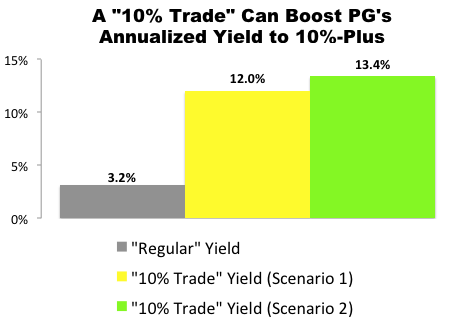Please keep in mind that these “10% Trade” alerts are for information purposes only. We’re not registered financial advisors and these aren’t specific trade recommendations for you as an individual. Each of our readers have different financial situations, risk tolerance, goals, time frames, etc. The ideas we publish are simply ideas that we feel fit our specific needs and that we’re personally making in our own portfolios. You should also be aware that some of the trade details (specifically stock prices and options premiums) are certain to change from the time we make our trade to the time you’re alerted about it. So please don’t attempt to make this “10% Trade” yourself without first doing your own due diligence and research.
A “10% Trade” can be a safe way to boost your income on some of the best companies in the world.
[ad#Google Adsense 336×280-IA]As a refresher, a “10% Trade” is a conservative income-oriented trade that involves selling either a covered call or a cash-secured put on a reasonably-priced, high-quality dividend growth stock.
If you’re working with a high-quality dividend growth stock that you think is trading at a reasonable price, you may be looking at a low-risk opportunity to generate above average income.
Consider the “10% Trade” I just made with Procter & Gamble (PG), a Dividend King poised for faster dividend growth…
Opportunity to Capture a 12.0% to 13.4% Annualized Yield from PG
On Friday I bought 100 shares of PG for $84.71 per share and simultaneously “sold to open” one February 17, $85.00 covered call for $1.85 per share.
With this in mind, there are likely two ways this trade will work out — and they both spell at least double-digit annualized yields on my purchase price…

Scenario #1: PG stays under $85.00 by February 17
If PG stays under $85.00 by February 17, I’ll get to keep my 100 shares.
In the process I’ll also have received $185.00 in covered call income ($1.85 x 100 shares).
The covered call income — known as a “premium” in the options world — was collected instantly on Friday. It was deposited in the account where I made the trade, which is my 401(k) retirement account.
At the end of the day, if “Scenario 1” plays out I’ll be looking at $175.55 in profit after commissions and fees.
On a percentage basis, I received an instant 2.2% yield for selling the covered call ($1.85 / $84.71).
When I subtract out the commissions and fees I’m looking at a 2.1% yield in 63 days, which works out to a 12.0% annualized yield.
Scenario #2: PG climbs over $85.00 by February 17
If PG climbs over $85.00 by February 17 my 100 shares will get sold (“called away”) at $85.00 per share.
Like “Scenario 1”, I get to keep the $185 in covered call income ($1.85 x 100 shares)… and I’ll also realize a $29 capital gain ($0.29 X 100) since I bought shares at $84.71 and will be selling at $85.
In this scenario, after commissions and fees I’ll still be looking at a $195.10 profit.
From a percentage standpoint, this “10% Trade” will deliver an instant 2.2% yield for selling the covered call ($1.85 / $84.71) and a 0.3% capital gain ($0.29 / $84.71).
After subtracting out the commissions and fees, I’m looking at a 2.3% total return in 63 days.
That works out to a 13.4% annualized yield from PG. Not bad, considering the stock’s “regular” yield is 3.2%.
Greg Patrick
DailyTradeAlert.com
P.S. I realize the typical financial advisor may think it’s crazy to trade individual stocks in a retirement account… no matter how safe the stocks may appear. And in many cases they’re probably right — especially if you’re not properly diversified and you’re heavily dependent on the income from this account. So I urge you not to blindly follow my lead today without first speaking to a professional advisor or doing your own due diligence and research. In addition, I’m not a tax advisor and I don’t claim to be… so please consult a professional for any tax related questions you have.


